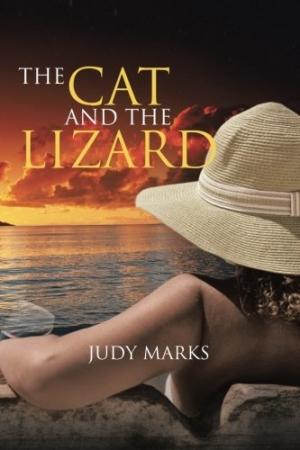The Cat and the Lizard
Family dysfunction meets the beauty of a Greek island in a story about family, control, and the damage done.
Judy Marks’s new book, The Cat and the Lizard, is a complex story about a family, a collection of assorted friends, and a destination wedding on a Greek island. For those interested in the nuances of the family dynamic, it provides a telling view of dysfunction and its implications within a family divided by divorce and tenuously united by remarriage.
Lisa, the primary narrator, is the mother of the bride. Although family and friends are spread throughout England and Scotland, daughter Sophie and fiancé Ian suddenly decide to marry—in Greece. Arrangements are rushed and finances tight, with coordination nearly impossible. Tempers flare, and feelings are hurt, but the wedding proceeds, minus many of the “usual” participants, including the father of the bride. It seems one more stressed and stressful event for a family whose lives are chronically out of sync.
Keeping the relationships straight among the characters can be difficult. Lisa is on her third marriage; Sophie and her brother are the products of her first. Ex-spouses, other marriages, assorted relatives, and in-laws abound. Lisa mentions that she once “tried to draw a family tree,” but it was “more horizontal than vertical,” and she gave up. It is easy to see why, although the diagram might be helpful here as a guide. With friends added to the mix, keeping track of everyone is a challenge.
Dysfunction reigns. Self-righteously indignant, catty and mean-spirited, rude and bossy, the characters seem bratty and spoiled. The collective dynamic is extreme, but as Sophie’s brother comments early on, “but then, it’s family, isn’t it?”
The family’s travels to, from, and around the island offer a lighter note. Bumbling tourist mishaps, missed connections, and language difficulties provide necessary levity. “How are you supposed to read maps and compare where you thought you ought to be with little snapshots at half past ten at night, stuck half way up a goat track with half a ton of luggage and no torch?” Lisa comments.
The Greek setting contributes a touch of beauty and a diversion from the intensity of the family interaction. The apparent serenity of the villa that houses the wedding guests, “white and gleaming in the moonlight, light streaming in stripes across the marble veranda from the shuttered windows,” contrasts dramatically with the turmoil in the lives of the people within.
Overall, Marks writes convincingly and well, although there are occasional, disconcerting jumps from Lisa’s first-person narration to a third-person voice. It takes a moment to realize that the voice has changed and it is no longer Lisa speaking. The text would benefit from a light re-editing. Small errors like “waste” for “waist” and “yoke” for “yolk” are easily correctable, and odd repetitions like “what whatever” and “passers passers-by” need to be addressed.
Those curious about the title, The Cat and the Lizard, will make the connection, as Lisa herself does, late in the book. A lizard that loses its tail to a predator can often grow another. There is, in the initial encounter, a question of control. The predator seems to have it, but does the predator actually bite off that tail, or does the lizard shed it voluntarily as a diversion to gain time to escape? The lizard eventually grows a new tail, but it is scarred, never the same as the original. Metaphorically, Lisa is that lizard. Control is a huge issue for her, but so too is the damage that has already been done.
Reviewed by
Cheryl Hibbard
Disclosure: This article is not an endorsement, but a review. The publisher of this book provided free copies of the book and paid a small fee to have their book reviewed by a professional reviewer. Foreword Reviews and Clarion Reviews make no guarantee that the publisher will receive a positive review. Foreword Magazine, Inc. is disclosing this in accordance with the Federal Trade Commission’s 16 CFR, Part 255.

